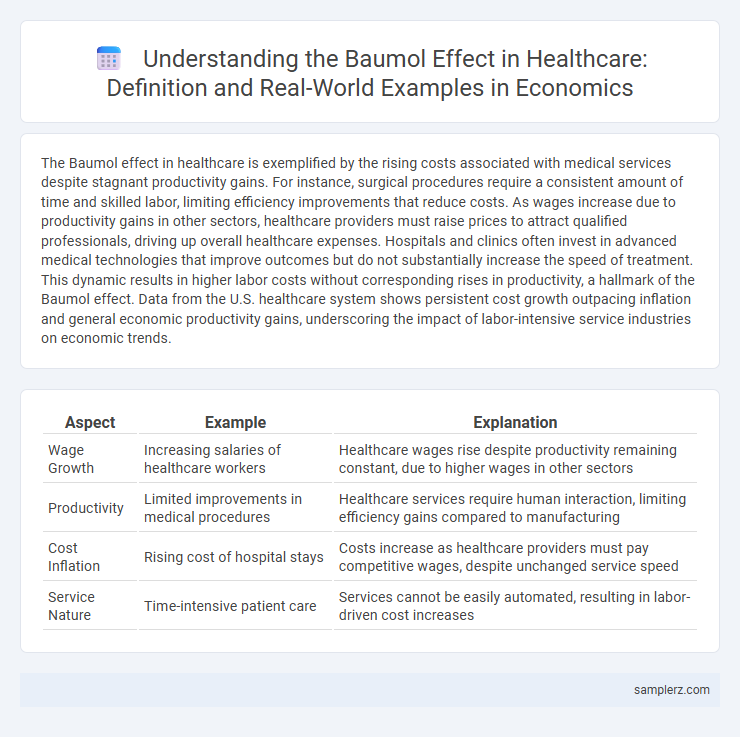The Baumol effect in healthcare is exemplified by the rising costs associated with medical services despite stagnant productivity gains. For instance, surgical procedures require a consistent amount of time and skilled labor, limiting efficiency improvements that reduce costs. As wages increase due to productivity gains in other sectors, healthcare providers must raise prices to attract qualified professionals, driving up overall healthcare expenses. Hospitals and clinics often invest in advanced medical technologies that improve outcomes but do not substantially increase the speed of treatment. This dynamic results in higher labor costs without corresponding rises in productivity, a hallmark of the Baumol effect. Data from the U.S. healthcare system shows persistent cost growth outpacing inflation and general economic productivity gains, underscoring the impact of labor-intensive service industries on economic trends.
Table of Comparison
| Aspect | Example | Explanation |
|---|---|---|
| Wage Growth | Increasing salaries of healthcare workers | Healthcare wages rise despite productivity remaining constant, due to higher wages in other sectors |
| Productivity | Limited improvements in medical procedures | Healthcare services require human interaction, limiting efficiency gains compared to manufacturing |
| Cost Inflation | Rising cost of hospital stays | Costs increase as healthcare providers must pay competitive wages, despite unchanged service speed |
| Service Nature | Time-intensive patient care | Services cannot be easily automated, resulting in labor-driven cost increases |
Understanding the Baumol Effect in Healthcare
The Baumol effect in healthcare manifests through rising costs driven by labor-intensive services like nursing and surgery, where productivity gains lag behind other sectors due to the human-centered nature of care. Despite advancements in medical technology, the growth of wages in healthcare remains high to attract and retain skilled professionals performing tasks that cannot be easily automated. This dynamic explains why healthcare expenses continue to rise faster than general inflation, impacting economic policy and resource allocation.
How Baumol’s Cost Disease Drives Medical Expenses
Baumol's Cost Disease explains rising medical expenses by highlighting how healthcare labor productivity lags behind other sectors, leading to higher wage demands without corresponding efficiency gains. As wages increase in competitive industries, healthcare providers must offer similar compensation, pushing up costs despite stagnant productivity. This wage-driven inflation in services like nursing and doctor consultations fundamentally drives the escalating healthcare expenditure.
Real-World Examples of the Baumol Effect in Hospitals
Hospitals experience the Baumol effect as medical procedures and patient care remain labor-intensive despite technological advancements, causing healthcare costs to rise faster than productivity. For example, surgical operations require skilled surgeons and nurses whose wages increase even though the procedure time remains constant, leading to higher overall treatment expenses. This wage-driven cost growth in healthcare services exemplifies the persistent challenges of cost control in the hospital sector due to Baumol's cost disease.
The Rising Costs of Nursing: A Baumol Perspective
The rising costs of nursing can be attributed to Baumol's cost disease, where labor-intensive healthcare services experience inflation despite limited productivity gains. Nurses' wages increase in line with sectors exhibiting higher productivity, such as manufacturing, driving up overall healthcare expenses. This dynamic intensifies healthcare inflation without corresponding improvements in service delivery efficiency.
Physician Salaries and the Baumol Effect
Physician salaries have surged due to the Baumol Effect, reflecting rising labor costs in healthcare despite stagnant productivity growth. This phenomenon occurs because medical services, requiring skilled human labor, cannot be easily mechanized or automated, pushing wages upward in response to increases in other sectors. As a result, healthcare expenses escalate, driven largely by the relatively higher wages needed to retain skilled physicians.
Comparing Healthcare Labor Costs to Other Industries
Healthcare labor costs have significantly increased due to the Baumol effect, as wage growth in this sector outpaces productivity gains when compared to industries like manufacturing, where automation drives efficiency. While manufacturing benefits from technological advancements reducing labor intensity, healthcare remains labor-intensive with limited productivity improvements, causing wages to rise faster. This disparity underscores the structural challenge of controlling healthcare expenses relative to other sectors experiencing technological progress.
Impact of Technological Advances and Baumol’s Theory
Technological advances in healthcare, such as robotic surgery and advanced diagnostic imaging, have increased productivity in some services but also escalated costs in labor-intensive care, exemplifying Baumol's cost disease. According to Baumol's Theory, sectors with lower productivity gains, like nursing and personal care, experience rising wages driven by competitive market pressures from more productive industries. This disparity results in higher overall healthcare spending despite technological progress, highlighting the economic challenge of balancing innovation with cost containment.
Baumol Effect and Healthcare Workforce Productivity
The Baumol Effect in healthcare manifests as rising costs due to stagnant productivity growth in the healthcare workforce, where services like patient consultations and nursing care require constant human time despite technological advances. Unlike manufacturing, healthcare labor productivity remains limited because quality care depends on direct provider-patient interaction, preventing cost reductions through automation. This dynamic drives up healthcare expenses as wages increase alongside more productive sectors, contributing to persistent inflation in medical service prices.
Case Studies: US Healthcare and the Baumol Effect
The US healthcare system exemplifies the Baumol effect, where wage increases in labor-intensive sectors like healthcare outpace productivity gains due to the difficulty of automating medical services. Case studies reveal that rising labor costs in hospitals and clinics contribute significantly to overall healthcare inflation despite relatively stable technological advancements. This dynamic underscores the persistent cost pressures in US healthcare driven by the inherent nature of patient care requiring skilled human intervention.
Policy Responses to the Baumol Effect in Healthcare
Policy responses to the Baumol effect in healthcare include increasing investment in medical technology to improve labor productivity and reforming payment systems to incentivize efficiency. Governments implement strategic funding models that emphasize preventative care and telemedicine to reduce labor-intensive procedures. These initiatives aim to counterbalance rising healthcare costs driven by wage increases in labor-intensive services without corresponding productivity gains.

example of baumol effect in healthcare Infographic
 samplerz.com
samplerz.com